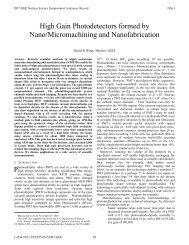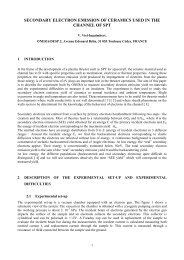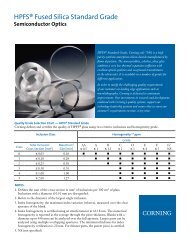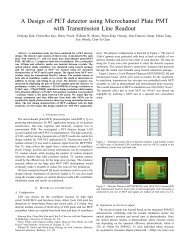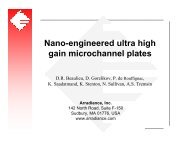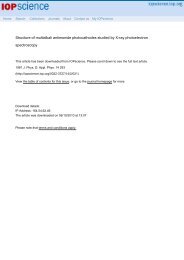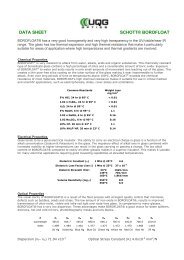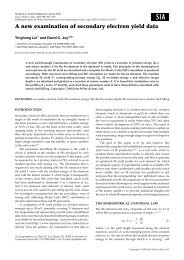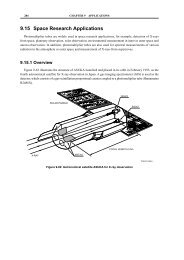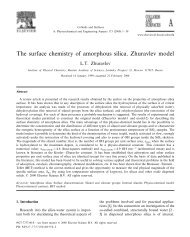the mechanism of channel electron multiplication - IEEE Xplore
the mechanism of channel electron multiplication - IEEE Xplore
the mechanism of channel electron multiplication - IEEE Xplore
Create successful ePaper yourself
Turn your PDF publications into a flip-book with our unique Google optimized e-Paper software.
1966 ADAMS AND MANLEY: MECHANISM OF CHANNEL ELECTRON MULTIPLICATION<br />
91<br />
ought to be some multiple pulses. All types <strong>of</strong><br />
curved multipliers produce secondary pulses to<br />
some extent, and tertiary and quaternary pulses<br />
are also seen, but <strong>the</strong>y are usually very small,<br />
so that <strong>the</strong>y do not make appreciable contributions<br />
to <strong>the</strong> pulse height distribution.<br />
The distribution broadens slightly as <strong>the</strong><br />
repetition frequency increases and <strong>the</strong> relationship<br />
between pulse height and time between pulses<br />
becomes more systematic. This is similar to <strong>the</strong><br />
saturation effect seen in straight <strong>channel</strong>s.<br />
OPERATIONAL CONSIDERATIONS<br />
It is now possible to indicate some operational<br />
characteristics <strong>of</strong> <strong>channel</strong> multipliers.<br />
A <strong>channel</strong> multiplier will detect any radiation<br />
which will excite <strong>electron</strong>s from <strong>the</strong> <strong>channel</strong> wall.<br />
Of course <strong>the</strong> <strong>channel</strong> entrance may be suitably<br />
treated to increase its detection efficiency for<br />
certain types <strong>of</strong> radiation. It is not an energy<br />
sensitive device in <strong>the</strong> sense that a sodium<br />
iodide crystal is for example. The pulses from<br />
<strong>the</strong> multiplier signify only that an input event<br />
has been detected.<br />
It is possible to make straight multipliers<br />
having a sharp pulse height distribution up to<br />
tens <strong>of</strong> kilocycles/sec by using resistive layers<br />
<strong>of</strong> about 109 Q. Straight multipliers have <strong>the</strong><br />
disadvantage that <strong>the</strong> gain depends upon gas<br />
pressure.<br />
Curved multipliers have a broader pulse<br />
height distribution in general, although it is<br />
narrower than that obtained from a conventional<br />
photomultiplier. The highest detectable count<br />
rate is determined by <strong>the</strong> resistance <strong>of</strong> <strong>the</strong><br />
<strong>channel</strong> and by <strong>the</strong> noise level in <strong>the</strong> multiplierpulse<br />
counter system. The choice <strong>of</strong> resistance<br />
is determined by <strong>the</strong> available power and <strong>the</strong> need<br />
for <strong>the</strong> <strong>channel</strong> material to satisfy certain<br />
requirements. It must be stable, for example,<br />
and it should have a reasonably high secondary<br />
emission coefficient. It is necessary to fabricate<br />
<strong>channel</strong>s in a variety <strong>of</strong> shapes and sizes,<br />
<strong>the</strong>refore <strong>the</strong> <strong>channel</strong> material must be easily<br />
worked. Count rates <strong>of</strong> <strong>the</strong> order <strong>of</strong> 105 pulses/<br />
sec above a 5 mV threshold are currently<br />
available.<br />
Gain maintenance is an important characteristic<br />
<strong>of</strong> <strong>channel</strong> multipliers but by <strong>the</strong> nature <strong>of</strong><br />
<strong>the</strong> problem, experimental evidence accumulates<br />
ra<strong>the</strong>r slowly. Deterioration <strong>of</strong> gain does take<br />
place and seems to be due to a combination <strong>of</strong><br />
material changes and surface contamination.<br />
Because <strong>of</strong> changes in <strong>electron</strong> trajectories<br />
in <strong>channel</strong> multipliers it is not possible to<br />
operate <strong>the</strong>m in magnetic fields <strong>of</strong> more than a<br />
few hundred gauss.<br />
CONCLUSION<br />
The <strong>channel</strong> multiplier is a useful research<br />
tool for detecting fluxes <strong>of</strong> energetic particles<br />
and radiation up to 105 output pulses/sec. At<br />
lower count rates it is possible to obtain gains<br />
<strong>of</strong> over 109 in straight <strong>channel</strong>s and 108 in<br />
curved ones. The limitation on gain is probably<br />
space charge in curved <strong>channel</strong>s and field<br />
distortion effects in straight ones.<br />
ACKNOWLE DGME NTS<br />
The authors wish to thank <strong>the</strong> Directors <strong>of</strong><br />
Mullard Ltd. for permission to publish and <strong>the</strong><br />
proprietors <strong>of</strong> "Electronic Engineering" in which<br />
Figures 1 and 7 were previously published. They<br />
are also grateful to Mr. R. Speer <strong>of</strong> <strong>the</strong> Mullard<br />
Space Laboratory, University College, London and<br />
Mr. C. Casemore, <strong>of</strong> Mullard Research Laboratories<br />
for many <strong>of</strong> <strong>the</strong> experimental measurements.<br />
APPENDIX I<br />
Electron Trajectories in Straight Channels<br />
The distance S travelled down <strong>the</strong> tube<br />
between collisions is given by<br />
S = 1E e t<br />
2 m<br />
E is <strong>the</strong> axial electric field.<br />
t is <strong>the</strong> time between collisions.<br />
t = d m<br />
2eV<br />
.... ... (1)<br />
. .... .. (2)<br />
V is <strong>the</strong> initial energy in volts, <strong>of</strong> an <strong>electron</strong><br />
emitted normally from <strong>the</strong> <strong>channel</strong> wall.<br />
d is <strong>the</strong> <strong>channel</strong> diameter.<br />
The collision energy, Vc. is given by<br />
V E S<br />
c<br />
v 2<br />
0<br />
_ o<br />
4 VIa2<br />
where V is <strong>the</strong> total voltage applied to <strong>the</strong><br />
0<br />
<strong>channel</strong>,<br />
and a is <strong>the</strong> length to diameter ratio.<br />
Let <strong>the</strong> secondary emission coefficient 6<br />
obey <strong>the</strong> relation<br />
6 = KV c<br />
K is a constant<br />
The gain G is given by<br />
G = n<br />
cd<br />
where n = S



